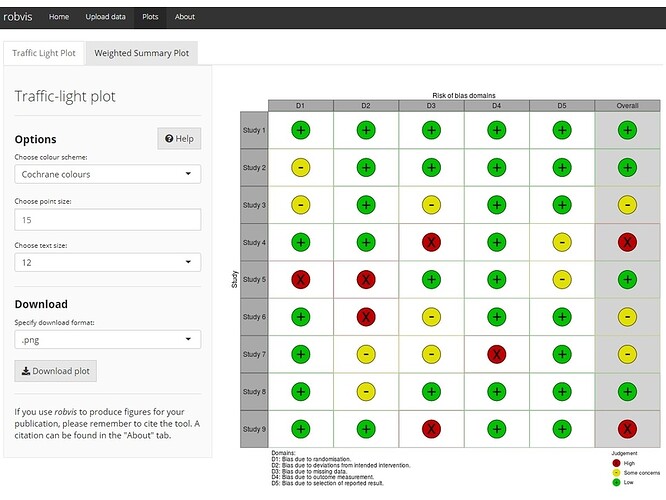robvis: Create publication quality risk-of-bias visualisations
Authors: Luke McGuinness
Working with Shiny more than 1 year
Abstract: Taking the advice of “do one thing well” to heart, the robvis webapp is designed to make it as easy as possible to create publication-ready risk-of-bias plots.
Full Description: Evidence synthesis – the drawing together of all available research on a topic to answer a pressing research question – is becoming more important than ever in informing policy across an increasingly wide range of fields. Risk of bias assessment - evaluation of whether the results of a study are likely to be subject to bias - often forms a key part of the evidence synthesis process, particularly in the health sciences. A well-developed family of tools is widely used for this purpose, all of which assign a judgement (e.g. “Critical”, “High”, Moderate”, or “Low” risk of bias) across a number of specific domains of bias. As an example, the first domain in the Cochrane RoB 2 tool for assessing randomized controlled trials deals with bias arising from the randomization process. Two plots are commonly used to summarize the results of these domain-based risk-of-bias assessments: a “traffic light” plot, which tabulates the judgement for each study in each domain (shown in the screenshot below), and a weighted bar plot, which show the proportion of studies with each judgement for each domain.
Built around the robvis (Risk Of Bias VISualiation) R package, this web-app allows users to create publication-quality versions of these risk-of-bias plots quickly and easily. While primarily designed for use with the major risk-of-bias assessment tools used in health research, the tool allows users to visualize the results from any domain-based risk-of-bias assessment or quality appraisal tool.
Key features of the app include:
- Example datasets for each risk-of-bias assessment tool supported by the app are provided. Alternatively, users can enter their data into the app manually.
- Uploaded data go through validation checks, with informative error messages. Users are unable to proceed to plot creation until any issues identified in the data have been resolved.
- A dynamic user-interface which guides users through the process, while a pop-up containing relevant guidance is available at each stage.
- A range of options are available to customize the plots (see screenshot)
- Finally, the plots can be downloaded in a range of formats (PNG, JPG, TIFF, EPS)
The tool has been well received and is beginning to be cited in the evidence synthesis literature (for example, see here.
Category: Research
Keywords: Research tool, systematic review, risk of bias, visualisation
Shiny app: https://mcguinlu.shinyapps.io/robvis/
Repo: GitHub - mcguinlu/robvisapp
RStudio Cloud: Posit Cloud
Thumbnail:

Full image:
